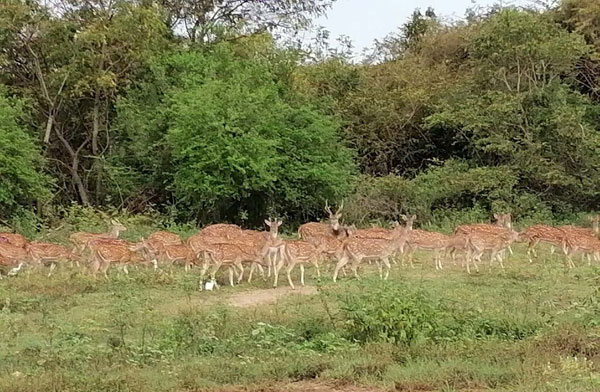News
Pandemic? No, it’s party time in Lanka’s wildlife parks: Animals are free, happy and making love

It's breathtakingly beautiful at the Udawalawe wildlife park, now a deer paradise
In Sri Lanka’s wildlife parks and zoological gardens, animals are free, happy, making love and leading a stress-free life because humans who disrupt their lifestyles have been placed under a lockdown due to the COVID-19 pandemic.
The wilds have come alive. Rarely seen animals are coming to the open, as human activities have come to a halt within animal sanctuaries. Leopards roam openly looking for prey, while large herds of deer graze on land abundant with fresh grass.
Yala National Park Warden Manoj Vidyaratne said no visitors had entered the park for the past one month and the animals were now one with nature.
“Large herds of sambar, spotted deer and wild boars can be seen along the park’s main tracks. Usually, timid animals stayed clear of the tracks as some 400 safari jeeps brought visitors to the park on a daily basis,” he said.

Unpurturbed by human activities, Udawalawe elephants are one with nature
A month ago, a visitor could see a maximum of three elephants in a herd, but wildlife officials now see larger herds with 15 to 20 elephants, the warden said.
He said the elusive leopard and the shy sloth bear were freely strolling on the park’s pathways used by safari jeeps.
“Even some pathways have been reclaimed by shrubs and become greener. The animals are happy. They have regained their natural lifestyle. They are free from the stress they underwent due to human activities in their habitat,” he said.
The story is not dissimilar in the Udawalawe National Park. Warden R.G.R.S. Ranatunga said animals were roaming freely and expressing a stress-free behaviour within the park as human activities had come to a virtual halt.
“The plants too have sprouted new growth while even the skittish deer have formed large herds and are roaming around in the open undisturbed. We see a lot of breeding activities. The deer population is increasing. We see many fawns running around in the park,” he said.
The park had undergone a positive change because the animals and plants are in their natural state, Mr. Ranatunga said, pointing out that they could see a significant change in animal behaviour when compared to how they behaved during times of tourism activities.

Freedom regained: Leopards roaming freely at Yala wildlife park
Similar views were echoed by Wilpattu National Park Warden Suranga Ratnayake.
The animals which usually stayed in the shrubs were starting to venture out in the open as there were no safari vehicles to disturb them within the park, he said. He said nowadays park rangers often spoke of seeing sloth bears and leopards with cubs inside the park.
The warden said as there were no visitors to the park these days, they could use the full force of wildlife officers for conservation activities such as carrying out raids to crack down on poachers and overall maintenance of the park.
“Before the outbreak of the pandemic, about 150 safari vehicles entered the park, carrying tourists and locals, but they only forced the leopards and bears to run away from their sight,” he said.
Meanwhile, researchers say situations such as countrywide lockdowns give natural ecosystems a chance to refresh.
Biodiversity Conservation and Research Circle Convenor Supun Lahiru Prakash said wildlife tourism had an adverse impact not only on the ecosystem, but also on animal behaviour, their health and reproduction system.
He pointed out that heavy traffic flows, reckless or poor driving by safari vehicle drivers and poor implementation of visitor guidelines by the park management caused disturbance to both plants and animals. These factors were also highlighted in a scientific study based on reviews by visitors to the country’s top five wildlife parks — Yala, Wilpattu, Horton Plains, Udawalawe, and Minneriya.
People should understand that the recovery of ecosystems within nature parks cannot be solved in a short time frame during travel restrictions and lockdowns, he said, calling for a continuous proper scientific management and implementation plan to minimise the impacts of wildlife tourism on wildlife resources.
| Safari drivers seek other jobs, agree with move to close parksAs the wildlife parks remain closed, safari jeep drivers are moving into other forms of employment.Safari jeep driver A.P. Shehan Sasindra told the Sunday Times that even though their business had been affected, they welcomed the Government’s move to close the parks as tourist movement could contribute to the spread of the pandemic. “We know the animals might be freely roaming in the park and this would be a good time to spot rare animals, but we had no option but to stay away from wildlife parks and focus on other employment avenues to earn a living,” he said. | |

